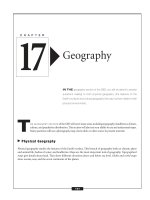About the GED Social Studies Exam
Bạn đang xem bản rút gọn của tài liệu. Xem và tải ngay bản đầy đủ của tài liệu tại đây (164.46 KB, 14 trang )
What to Expect on the GED Social Studies Exam
The GED Social Studies Exam covers basic social studies concepts and includes questions from four main con-
tent areas including U.S. (or Canadian) and world history, geography, civics and government, and economics. The
test applies these four topics to your daily life and looks at how they affect your role as an individual, a member
of a community, a family member, a worker or student, and a consumer. You will not be asked to memorize
facts—instead, the test will measure your critical thinking skills. These skills include your ability to understand,
analyze, and evaluate social studies material.
The Social Studies Exam includes 50 multiple-choice questions. Each question has five answer choices.You will
have 70 minutes in which to complete all 50 questions. The test will include some question sets, meaning that
several questions may address a single graphic or reading passage. Question sets usually have between two and
five items. The test may require you to use your understanding of different social studies concepts within the same
question set.
CHAPTER
About the GED
Social Studies
Exam
TO PREPARE effectively for the Social Studies Exam, you need to
know exactly what the test is like. This chapter explains the structure
of the exam, including the types of questions and stimuli you will see
on the test.
13
129
Kinds of Stimuli
Test questions are based on three kinds of stimuli mate-
rials: reading passages, visuals, and combined stimuli
that use both reading passages and visuals. Here is what
you can expect on the Social Studies Test:
■
Reading passages from articles, speeches, text-
books, laws, or other documents. Reading pas-
sages range in length from 50 to 70 words for
single-item questions and from 150 to 170 words
for question sets. Forty percent of the questions
on the Social Studies Test will be based on read-
ing passages. The test will include one or more
excerpts from the U.S. Declaration of Indepen-
dence, U.S. Constitution, Federalist Papers, and
Supreme Court landmark cases. Review these
documents before taking the test to familiarize
yourself with their fundamental concepts.
■
Visuals including maps, graphs, charts, tables,
diagrams, photographs, and political cartoons.
More than half the questions on the exam are
based on some form of graphic. The test will also
use one practical document like a voter’s registra-
tion form, consumer guide, tax form, budget,
survey, workplace contract, bank statement,
insurance form, or other document.
■
Combined stimuli using both text and visuals.
Combined materials make up 20% of the test’s
questions.
GED Components
Here is a quick breakdown of how material will
be presented on the Social Studies Exam:
Reading Passages 40%
Visuals 40%
Combined Text and Visuals 20%
Kinds of Questions
The questions on the Social Studies Exam measure four
major thinking skills: comprehension (your ability to
understand), application (apply information to new sit-
uations), analysis (break down information and analyze
it), and evaluation (make judgments about information).
Here is the breakdown of the types of questions on the
Social Studies Test:
Comprehension 20%
Application 20%
Analysis 40%
Evaluation 20%
Each question type examines a different thinking skill.
■
Comprehension. For these questions, you will
read passages or review visuals and demonstrate
that you understand the meaning of the text or
graphic. To answer these questions, you may need
to restate information that you have read, sum-
marize ideas from a passage, or draw conclusions.
When answering these types of questions, do not
use any prior or additional knowledge of a sub-
ject that you might have. Some test questions
measure your ability to find the best answer based
only on the information that is provided. Com-
prehension questions are typically worded as in
the following examples:
➧ Which of the following best describes the
passage?
➧ What is the purpose of this paragraph?
➧ According to the map, which of the following is
true?
➧ What conclusion can you make based on the
information in the chart?
■
Application. To answer these questions, you take
information or ideas from one situation and
apply them to a different situation. Here are some
examples of application questions:
➧ Who might use the information in this graph
to support their position?
➧ Which of the following is the most similar to
the situation described above?
■
Analysis. For these questions, you need to break
down ideas and show relationships between ideas.
You might be asked to differentiate between fact
and opinion, identify an assumption that the
author has made even if he or she did not state it
explicitly, identify cause and effect relationships,
or compare and contrast information or ideas.
–
ABOUT THE GED SOCIAL STUDIES EXAM
–
130
Typical analysis questions may be worded as in
the following examples:
➧ Based on the quotation, what can we infer
about the speaker?
➧ The writer has not directly stated, but would
support, which of the following statements?
■
Evaluation. To answer this type of question, you
will synthesize information and make your own
hypothesis or theory. Some questions will require
that you evaluate information or ideas and make
a judgment about whether the information is
accurate. You will need to look at data to back up
conclusions, identify how values and beliefs shape
decisions, and uncover arguments that might be
illogical. Here are some examples of typical evalu-
ation questions:
➧ Which of the following is supported by the
information given in the passage?
➧ Which of the following is an unlikely explana-
tion of the information presented in the graph?
➧ Which of the following expresses an opinion
rather than a fact?
Test Topics
The test covers four main subjects: history, geography,
civics and government, and economics. Although you will
not need to memorize facts from these four categories, you
will need to use your knowledge of social studies concepts
and apply your critical thinking skills. This will help you
review key social studies terms and offer basic information
in each content area. For further information about a
topic, see the Web resources listed on page 167.
Four Main Subjects
The GED Social Studies Exam covers these
four topics:
History United States
(or Canada), 25%;
World, 15%
Geography 15%
Civics and Government 25%
Economics 20%
If you have taken the Social Studies Test before or if
you are an instructor helping others prepare for the test,
you will notice some differences in the test from past
years. The behavioral sciences—psychology, sociology,
and anthropology—no longer appear on the test as a
separate topic. Some major concepts in these topics,
like law, culture, race, society, and religion, are now
included within other areas. The topics of human health
and development are not part of the updated Social
Studies Test.
What’s New for the GED?
In 2002, the GED was revamped with a new emphasis for
the Social Studies Test. The test now includes more his-
tory questions and a greater percentage of civics and gov-
ernment questions than in past years. The U.S. edition of
the test covers topics from major world and U.S. histor-
ical eras, as well as major topics within the studies of
geography, civics and government, and economics. Sixty
percent of the items or passages in the test have a global
or international context. Forty percent concern specific
developments in U.S. history. In some cases, the United
States factors into the international setting, while in oth-
ers, questions focus on different parts of the world. The
Canadian version of the test is structured the same way,
but emphasizes Canadian, rather than U.S., history
The current test has an emphasis on the way material
is presented, with graphic or visual source materials
making up the majority of the test’s stimuli. In addition,
the test has a greater percentage of questions that meas-
ure the thinking skill of analysis than in past years.
If you took the test before 2002, this chart highlights
the changes you will find in the Social Studies Exam.
Changes in More history questions
content More civics and government
questions
Behavioral science no longer a
content area
Changes in More questions based on visual
format source materials
More single-item questions
Changes in More questions that measure
thinking skills the thinking skill of analysis
–
ABOUT THE GED SOCIAL STUDIES EXAM
–
131
Defining “Social Studies”
Social studies is the study of how people live every day. It explores many aspects of life: the physical environment
in which people live, the beliefs and traditions they follow, and the societies in which they live. Social studies
include many different fields, broadly described as history, civics and government, economics, and geography.
Each of these four categories is related to the others. To understand an event or a complex issue, you would exam-
ine all four branches of social sciences. For example, if you were studying the stock market crash of 1929, you
would explore what was happening in the country at the time (history); how the free enterprise system works
(economics); what programs and policies were implemented to safeguard against another crash (civics and gov-
ernment); and how this event affected people in different areas of the country and why (geography).
The next four chapters introduce you to key terms and offer information about major topics in the four sub-
jects of the Social Studies Test. The exercises in these chapters will help you review the information you learn.
Practice questions are similar to those on the GED. For additional information about these subjects, see the list
of Web resources on page 167.
CHAPTER
World History
IN THIS section, you will learn about social studies in the GED con-
text: what the test is like, what kind of questions to expect, and how
to tackle those questions. You will also review the fundamental content
areas and skills you need to do well on the exam.
14
133









